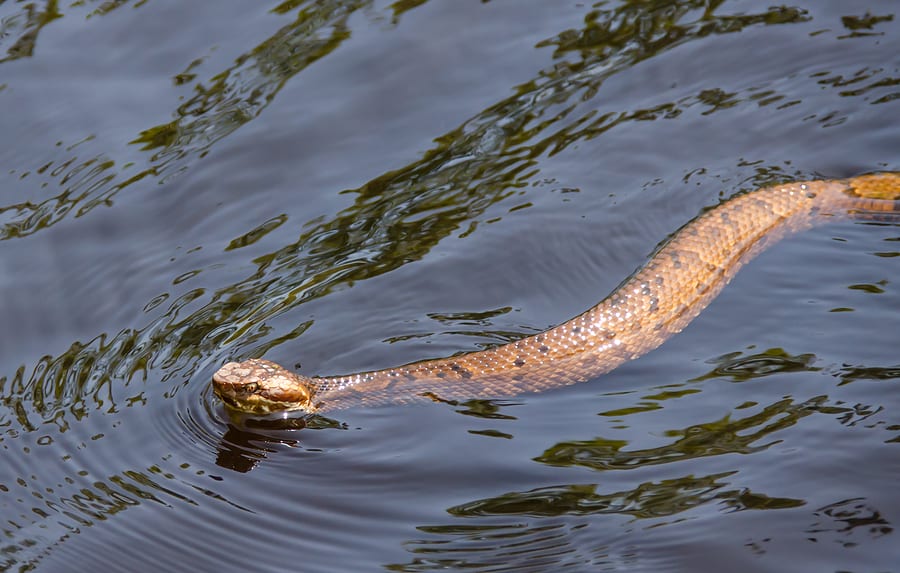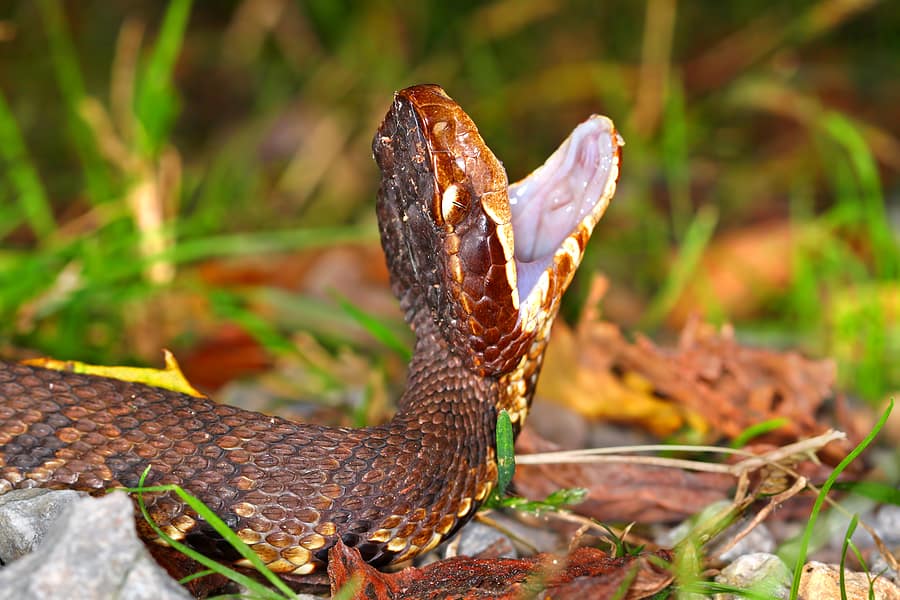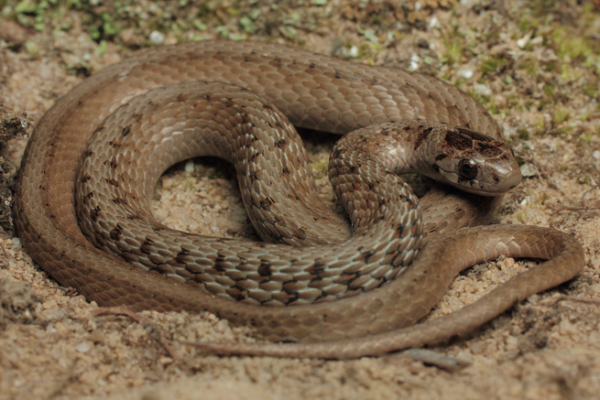READY TO GET STARTED?
REQUEST A FREE ESTIMATE
Fill out the form below or call (888) 466-7849 for a free, no-obligation estimate.

Water moccasins, also known as cottonmouths, are one of 6 venomous snake species found in Georgia. These snakes are often mistaken for non-venomous water snakes (which are illegal to kill in the state of Georgia). Water moccasins are found in most areas of Georgia with the exception of the northern central region. While they often sunbathe on land, logs, or stumps found near water sources, they will also inhabit swamps, backwaters, and slow-moving streams.
Water moccasins are large, heavy bodied snakes with dull colors and rough scales. They have a single row of these scales under their tails (while water snakes have a double row). They also have elliptical eye pupils and heat sensing pits between their eyes and nostrils. Most have banding on their bodies with wider bands on the sides that narrow and taper near the top. These bands look like hourglasses when looking at them from above. They also have a dark stripe that runs from the back of their eye to the corner of their jaw which distinguishes them from water snakes and other species.
When agitated, water moccasins will vibrate their tails (similar to a rattlesnake rattle) and gape their mouths open, exposing the white coloration inside (hence the name cottonmouth). While these snakes have gotten a reputation for being aggressive, they are actually more likely to flee when encountered.
Water moccasins prefer to lay on logs and tree limbs near the water’s edge but will move into the water, as well. They can open their mouths and bite underwater, often hunting for frogs while swimming. The way they swim is also a distinguishing factor for these snakes. Water moccasins swim with their bodies riding on the surface of the water and their heads elevated above the water. They don’t typically submerge underwater, although they can. Water snakes will dive underwater when fleeing from a disturbance.
If you encounter a water moccasin in the wild, don’t panic. Stop moving towards them and back away slowly. Steer clear of them as you make your way away from them. Don’t ever attempt to kill or move a venomous snake on your own. If one makes its way into your home, call a professional wildlife control company for proper snake removal and relocation.
To keep water moccasins from lurking around your home, minimize stacks of wood near your house, get rid of standing water, bush piles, and any other moisture prone cover they can use. They also love to eat frogs so keep populations of these reduced around your property. They love wet hiding places with decaying plants or wood. Keep your home and yard clear and dry.
If you have a problem with snakes, contact your local pest control company for assistance.
How to Enjoy a Bed Bug Free Vacation
How to Handle a Termite Infestation

As the weather warms up, snakes will emerge to take advantage of the warm weather and kick start their mating season. One of the snakes you’ll start to see this spring is the water moccasin. This venomous snake, also known as the cottonmouth, is a semi-aquatic snake found throughout the southeastern United States. The water moccasin is often mistaken for other snakes, so recognizing this snake in the wild is critical.
Water moccasins have large, triangular shaped heads with large jowls (due to their venom glands). Their eyes have a dark line through them and elliptical-shaped pupils. These snakes are large in size, ranging from 24″ to 48″. They have thick, heavy bodies when compared to their length. Their coloration can vary. These snakes can be completely brown or black (usually adults) or brown or yellow with dark crossbands. Adults tend to be darker while juveniles tend to be more brightly colored. They also have dark brown or yellow blotches on their bellies and black on the underside of their tails.
Water moccasins have facial pits they use to sense heat from predators and prey. They got their cottonmouth alias because the inside of their mouths are white in color. They will gape when they feel threatened, exposing this white color in an attempt to scare the threat away.
These snakes are found throughout the southeast, as far north as Virginia. They can be found in almost any freshwater habitat. They are active both during the day and at night, but will commonly hunt at night, especially during the hotter seasons of the year. They eat a variety of prey, including lizards, amphibians, other snakes, small turtles, birds, fish, mammals, and even baby alligators. They mate in the early summer.
Water moccasins are often mistaken for other nonvenomous water snakes. While the water moccasin has a thick body and short, thick tail, nonvenomous water snakes have more slender bodies and thinner tails. The shape of the head is also important. Water moccasins have large, blocky heads with pronounced necks that are much more narrow than the head. Water snakes, on the other hand, have more slender heads with necks that are more comparable in width to their heads.
While it can be tempting to run away or grab the closest thing you can to kill a snake when you come across it, the best practice is to leave it alone and slowly back away. In the case of a venomous snake, contact your local pest control company who can implement safe snake removal and relocation techniques.

Despite popular belief, not all snakes are harmful to humans. In fact, most snakes will go out of their way to avoid humans when they encounter them. Only a handful of venomous snakes reside in Georgia. One of the most common of these is the water moccasin.
Water moccasins, also known as cottonmouths, is a venomous snake found throughout the southeastern United States. They are known as the cottonmouth because of the white coloring on the inside of their mouths that show when they are threatened. These snakes are usually a banded brown or yellow color. They range in size anywhere from 2 to 4 feet and can swim in the water and slither on land.
The bite of a water moccasin is very dangerous to humans. If you are bitten by a water moccasin, seek medical attention immediately. Symptoms following a water moccasin bite include pain, swelling, discoloration, weakness, fatigue, difficulty breathing, nausea, and decreased blood pressure.
Adult water moccasins have control over their venom. Because they have a limited supply, they have learned to conserve it, sometimes biting with a “dry bite” where no venom is released. Although painful, these bites aren’t as dangerous as a venom-filled bite. This is also what makes baby and juvenile water moccasins so dangerous. These young snakes haven’t learned control over their venom yet, therefore injecting their full supply when they bite.
If you encounter a water moccasin or any other snake you can’t positively identify in the wild, steer clear of it and don’t enter it’s personal space. Don’t attempt to move it or kill it. If you come across one of these snakes in your home, contact a professional for safe removal and relocation.
Although most snakes are actually beneficial to have around your home, you can prevent snakes with the following tips:
If you encounter a snake, contact a local pest control company who can implement safe and humane snake removal protocols.
Roof Rats: How To Identify and Eliminate
Common Rodents to Lookout for this Winter
Getting Ready for Spring Lawn Care

Fall is here! Football has started, bonfires are lit, and the weather is bringing more people outside. Though now is the time for all the Fall fun, you aren’t the only one enjoying this weather. Those snakes that slither through the tall grass and the woods of your backyard also appreciate this time of year! They can be intimidating creatures, but they also shouldn’t draw too much concern from the average person.
In Georgia it is illegal to kill certain snakes, punishable with fines of up to $1000 and/or up to one year in jail. This shouldn’t be an issue for most of us, however, because snakes want to avoid us just as much as we want to avoid them. Did you know that most snakes in Georgia are non-venomous with only six being venomous?
Let’s touch on these 6 venomous species of snakes and how you can tell which is which:
Eastern Coral Snake: This snake is easily recognized. You can tell them apart by the red and black segments on their body separated by yellow rings. Unlike the other snakes on this list, the coral snake has a rounded snout.
Copperhead: The copperhead usually has a light brown to gray skin color, but they can range from rusty orange to nearly black. You can recognize them easily by the 10 to 21 dark-brown hourglass-shaped crossbands on their body. Look out for their triangular shaped head, as well.
Timber Rattlesnake: They have background skin that can be a variety of different colors, ranging from shades of pink, yellow, gray, brown, or black. It has brown to black V-shaped bands down its body. It has a black tail with a rattle at the tip.
Pigmy Rattlesnake: They are usually gray or tan but can be reddish or black. The pattern on its body resembles blotches or spots that are dark in color. The tip of the tail has a rattle.
Cottonmouth: The cottonmouth has light brown or olive-colored skin with dark bands along their bodies. When they mature they may become very dark, obscuring the bands completely.
Eastern Diamond Rattlesnake: Its body is patterned with a row of diamond-like shapes that are dark brown in color. Each shape is outlined by a yellowish border. The tail has 3 to 10 brown and white bands and a rattle.
Before snakes go into hibernation, there’s a chance you might see one in your yard or while you’re out for a walk. In a situation like that, avoid the snake, and call your local pest control company to relocate it for you. And remember, it doesn’t want to hurt you, so don’t hurt them.

Fall will soon be upon us! As the temperatures cool down we want to get outdoors and enjoy the milder weather at the turn of the season. But BEWARE! Snakes are also active during this time of the year. Most snakebites occur between April and October when the weather is still warm and outdoor activities are popular. Fall is breeding and hatching season which makes males more aggressive as they are trying to get the attention of female snakes. Newly hatched snakes are also aggressive as they are trying to avoid predators. Snakes are also preparing for hibernation or brumation (where they don’t actually sleep but instead slow their metabolism to acclimate to the cooler temperatures) which makes them more active during this time of the year. Here are some common snakes you may encounter in southern states and what you can do to keep them away from your home.

Black racers are large snakes (usually over 5 feet long). They are slender and solid black in color, although some may have a white chin. They are often mistaken for other large, black snakes. Juveniles look completely different, usually gray in color with darker blotches. They tend to flee quickly when threatened. They are found throughout the eastern US. They can be found in any habitat but are more common in old fields, near forest edges, and the edges of wetlands. They are non-venomous but may bite if handled.

Brown snakes are small (usually only 6-13 inches in length). Most of them are brown in color but they can yellow, reddish, or grayish brown and can have darker spots on their backs. They can be found in wooded areas, near wetlands, and in urban areas. They are not found in areas of high elevation. They like to live under debris in residential areas or any other area with enough groundcover. They are non-venomous but may bite if handled.

Copperheads are large snakes (usually 2-4 feet long). They have a distinctly triangular shaped head. They are tan to brown with darker hourglass shaped bands on their bodies. Juvenile copperheads have a distinct yellow-tipped tail. They are found in semi-protected areas like woods and swamps but may also be found in urban areas. They are found throughout the central and eastern US, with the exception of some parts of South Georgia and the entire state of Florida. They are venomous and may bite if they feel threatened.

Coral snakes are medium sized (1.5 to 2.5 feet long). They are brightly colored red, yellow, and black. If they feel threatened, they will lift up their tail and curl the tip over. Although they spend the majority of their time underground, they can be found in pine and scrub sandhill habitats, hardwood forests and pine flatwoods, and in suburban areas. They are found throughout much of the southern coastal plain, although they are most common in Florida. They are venomous and may bite if they feel threatened.

Garter snakes are small to medium sized (1.5 to 4 feet long). They have dark colored bodies with three yellow stripes running vertically. They prefer protected areas such as woods or marshes but are also common in grassy areas and around water. They are very common in suburban areas as long as there is adequate cover for them. They are common throughout the Southeast and most of the US. They are non-venomous but may bite if handled.

King snakes are large snakes (3-4 feet long). They are a shiny black color with white or yellow bands. They have a rectangular looking head with a short, blunt snout. They are found in protected areas such as woods, overgrown vegetation, and cluttered areas. They are found throughout the southeast US. They are non-venomous but may bite if handled or threatened.

Rat snakes are large snakes (most 3-5 feet long but some longer than 6 feet). Their coloring depends on the region they live in and can be black, yellow with stripes, or gray with darker patches. They are found in semi-protected areas such as woods, overgrown vegetation, swamps, or abandoned and vacant buildings. They are found throughout the southeast US. They may climb for food. They are non-venomous but may bite if handled or threatened.

Water moccasins are also known as cottonmouths. They are large snakes (2-4 feet long). Their color varies from solid brown to yellow with dark crossbands. Juveniles have a yellow-tipped tail. Their head is distinctly triangular. When threatened they have a characteristic display with their head in the middle of their coiled body and their mouth wide open. They are found in freshwater habitats, cypress swamps, river floodplains, and heavily vegetated wetlands. They are found throughout the southeast US but are more common in coastal regions. They are venomous snakes and may bite when threatened.
While it is impossible to prevent snakes, there are things you can do to avoid them and prepare yourself and your family when you are enjoying the outdoors. Check out these 10 tips to avoid snakes: